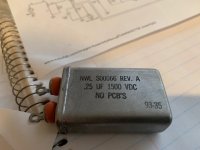Similar to this? There is a datasheet clicky on the web page.
https://cpc.farnell.com/ducati/4-16...-450vac-tab/dp/CA05818?st=motor run capacitor
https://cpc.farnell.com/ducati/4-16...-450vac-tab/dp/CA05818?st=motor run capacitor
Attachments
A quick google search found this
https://www.capacitorindustries.com/wp-content/uploads/Run-and-Start-Capacitors.pdf
My ~1Hp submersed well pumps use 20-30uF capacitors. So this must be meant for a small motor.
https://www.capacitorindustries.com/wp-content/uploads/Run-and-Start-Capacitors.pdf
My ~1Hp submersed well pumps use 20-30uF capacitors. So this must be meant for a small motor.
Last edited:
Cheers guys!! 🙂 Yes very similar, it's for a small motor I guess but if I do use it down the track I'll have to work out if it's a run or a start cap, if you use a start cap as a run cap it can damage it or even explode as a run cap is in circuit all the time. If it's a start cap the motor starts then a centrifugal switch kicks in after some time taking the cap out of circuit to prevent damage.
I don't think it's clear which one it is??? I'm hoping that someone finds it familiar haha. I'll look at those links you suggested 🙂
I don't think it's clear which one it is??? I'm hoping that someone finds it familiar haha. I'll look at those links you suggested 🙂
Would the low value and high voltage suggest its more likely to be a 'Run' than a 'Start' component.
Start caps are usually much higher uF value. You can get the two combined in one can such as a 1.5uF run and 80uF start.
Start caps are usually much higher uF value. You can get the two combined in one can such as a 1.5uF run and 80uF start.
Thanks Mooly
Yes you would think so BUT BUT BUT there's a lot of people saying different.
Some say higher values are start capacitors then some websites list the lower values as start caps.
Wouldn't you think there would be an easy way of telling them apart??? haha
Yes you would think so BUT BUT BUT there's a lot of people saying different.
Some say higher values are start capacitors then some websites list the lower values as start caps.
Wouldn't you think there would be an easy way of telling them apart??? haha
Its not really an area I'm familiar with in practice.
Its a bit like saying is 1uF cap a signal coupling cap or a reservoir cap in a power supply. Obvious answer is signal coupling but it doesn't have to be that way, it could be used as either as long as it was operated within its limits such as power dissipation and allowable ripple current.
It all depends on the application.
Its a bit like saying is 1uF cap a signal coupling cap or a reservoir cap in a power supply. Obvious answer is signal coupling but it doesn't have to be that way, it could be used as either as long as it was operated within its limits such as power dissipation and allowable ripple current.
It all depends on the application.
Thanks Mooly 🙂
yeh that is true BUT I heard from multiple places if you use a start up capacitor as a run capacitor it could even blow up as a start up cap is not designed to be in circuit all the time, the start up cap in devices like bench grinders lets the motor spin up and after it gets to a certain rpm the centrifugal switch takes it out of circuit preventing damage.
The silly question is how do you know if it's a run or a start cap? wouldn't you think it would be clearly labeled as it can blow up!! You don't want 250v at 10amps going bang in your face. I've seen caps go off like bullets no joke they can be so dangerous.
Cheers again guys 🙂
yeh that is true BUT I heard from multiple places if you use a start up capacitor as a run capacitor it could even blow up as a start up cap is not designed to be in circuit all the time, the start up cap in devices like bench grinders lets the motor spin up and after it gets to a certain rpm the centrifugal switch takes it out of circuit preventing damage.
The silly question is how do you know if it's a run or a start cap? wouldn't you think it would be clearly labeled as it can blow up!! You don't want 250v at 10amps going bang in your face. I've seen caps go off like bullets no joke they can be so dangerous.
Cheers again guys 🙂
The EN 60252-1 standard mentioned at the below right on the capacitor gives the definitive answer. The standard applies exclusively to motor run capacitors. If it were a start capacitor, the cap would have been covered by the -2 version. So look no further, it's a motor run cap.
If you want to see for yourself, go here and read the standard's scope in the preview:
IEC 60252-1:2010+AMD1:2013 CSV | IEC Webstore
If you want to see for yourself, go here and read the standard's scope in the preview:
IEC 60252-1:2010+AMD1:2013 CSV | IEC Webstore
Last edited:
- Home
- Design & Build
- Parts
- Capacitor I.D


